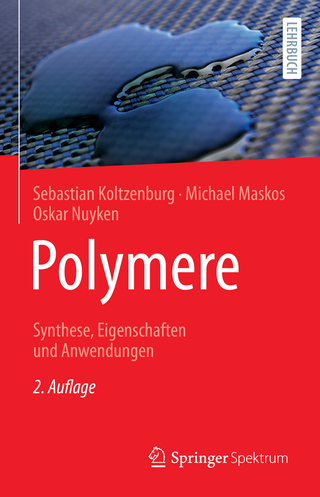
Inorganic Chemistry An Integrated Approach
Oxford University Press (Verlag)
978-0-19-890599-8 (ISBN)
- Noch nicht erschienen (ca. März 2025)
- Versandkostenfrei innerhalb Deutschlands
- Auch auf Rechnung
- Verfügbarkeit in der Filiale vor Ort prüfen
- Artikel merken
robust problem-solving feature. A comprehensive and up-to-date resource, Inorganic Chemistry's unique approach to combining core topics in this area results in a highly accessible textbook appropriate for mid- to
upper-level students.Key features•An integrated approach: The text presents a set of core models, such as VSEPR, Valence Bond Theory, and Ligand Field Theory, to show how these can be applied in different ways.•Highlights modern research: Examples, applications, and references introduce students to current perspectives and recent scholarship in the
field.•Teaches projection operators with group theory: Teaches these subjects together, thereby making clear the connection between symmetry and molecular orbital theory.•Highlights magnetism: The central role of magnetism is highlighted, a unique feature of this
text.•Offers comprehensive coverage of bioinorganic chemistry through both a stand-alone chapter on the topic as well as integrated examples throughout the text.•Robust problem-solving package that includes numerous in-chapter worked examples and extensive end-of-chapter problem sets. EOC problems consistently refer to the primary literature.•Simple, clear illustrations in full
color that help students visualize complex chemical reactions and concepts.•A comprehensive resource: Written for mid- to upper-level courses in inorganic chemistry, the text includes many topics not covered in existing inorganic texts. Students get a
resource for their entire academic careers, and instructors will no longer need to supplement their existing books' coverage.Inorganic Chemistry is available for students and institutions to purchase in a variety of formats: the e-book and Science Trove offer a mobile experience and convenient access along with practice problems, functionality tools, navigation features, and links that offer extra learning support. For more information about e-books,
please visit www.oxfordtextbooks.co.uk/ebooks.
Aaron Odom Aaron has a Ph.D. from Massachusetts Institute of Technology and is currently a Professor of Chemistry at Michigan State University. His research group studies inorganic and organic synthesis, applications of catalysis to pharmacologically active compounds, and modeling of catalytic reactions. Remi Beaulac Remi Beaulac has a Ph.D. from University of Montreal and is currently a Professor of Chemistry at Swarthmore College. His research is in energy processes in inorganic nanomaterials. Adam R. Johnson Adam R. Johnson is a Professor of Chemistry at Harvey Mudd College where his research group studies chiral early metal complexes. He is a founding member of the Interactive Online Network of Inorganic Chemists. Mitch R. Smith Smith took what he learned about synthesis, reactivity, and mechanistic studies from his mentors Dick Andersen and Greg Hillhouse, and applied them in the field of catalysis. Researchers from Smith's group and those from groups of his collaborators have made important advances in C-H functionalization, electrocatalysis, and polymer science. James K. McCusker Jim McCusker received a Ph.D. from the University of Illinois at Urbana Champaign and is a Foundation Professor in the Department of Chemistry at Michigan State University. In his research, he studies fundamental aspects and applications of ultrafast processes and magnetic behavior in inorganic complexes. Chip Nataro Chip Nataro is the Marshall R. Metzgar Professor of Chemistry at Lafayette College in Easton, PA, USA. His research focuses on the synthesis, characterization and catalytic applications of transition metal compounds with bis(phosphino)metallocene ligands.
1: What is inorganic chemistry, and why study it?
2: A brief review of physical chemistry
3: Basics of bonding: the 2-Center 2-Electron (2c2e) Bond
4: The shapes of main group molecules: the VSEPR Mode
5: Symmetry and group theory
6: Group theory and molecular orbital theory
7: Hybridization-based theories of bonding: applications within the main group
8: Main group bonding
9: Applying bonding principles to main group reactivity and properties
10: Introduction to transition metal chemistry
11: Basics of transition metal bonding 1: Simple ligands including olefins, diatomics, phosphines and hydrides
12: Basics of transition metal bonding 2: conjugated p-systems, metal-ligand multiple bonds, and other ligand types
13: Thermodynamic considerations in reactivity: acid-base theory and redox reactions
14: Understanding transition metal complexes using hybridization-based theory
15: The one-electron picture of transition metal electronic structure
16: Optical spectroscopy and excited state electronic structure
17: Kinetics and mechanisms of ligand substitutions
18: Some practical aspects of mechanism elucidation
19: Reactivity in organometallic chemistry
20: Solid-state chemistry
21: Bioinorganic chemistry
22: f-Element chemistry
Appendix A, Polar covalence
Appendix B, Some representative bond distances and bond energies
Appendix C, Tabulated values for determination of bond order: r0 and b
Appendix D, Character tables
Appendix E, Review of matrix manipulations
Appendix F, Common SALCs and normal modes
Appendix G, Matrices associated with strong field parameters
Appendix H, Changes in atomic radius with charge and coordination number
Appendix I, Imaginary numbers and complex conjugates
Appendix J, Standard reduction potentials
Appendix K, Valence orbital energies
| Erscheinungsdatum | 05.03.2024 |
|---|---|
| Verlagsort | Oxford |
| Sprache | englisch |
| Gewicht | 1 g |
| Themenwelt | Naturwissenschaften ► Chemie ► Anorganische Chemie |
| ISBN-10 | 0-19-890599-8 / 0198905998 |
| ISBN-13 | 978-0-19-890599-8 / 9780198905998 |
| Zustand | Neuware |
| Haben Sie eine Frage zum Produkt? |
aus dem Bereich


